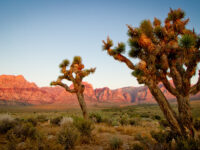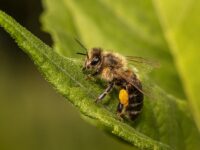The first time I fell in love was in the Sonoran Desert. I had just pulled over to the side of the road and there it was. An Ocotillo cactus, in all its glory, stood proudly before the rugged landscape. Its fluid tentacle-like stems pointed towards the sky, like a sea anemone frozen in turbulent water. As I got closer, I could see the branches were comprised of hundreds of small disks, each attached by their narrow edges to an undulating green stem. Displays of otherworldly features like these are the key to understanding how plants survive in unforgiving climates.
Deserts receive an average of 10 inches of rain per year, making them some of the harshest biomes on earth. Subsisting on minimal water and extreme temperatures is no easy task. One may think that extreme drought would leave these places devoid of life; however, the desert is far from deserted.
“Though cacti are the quintessential desert plant, they’re not the only ones to have adjusted to life in arid landscapes.”
2,500 species of cacti fall within the Cactaceae family. Of these numerous species, all but the Rhipsaslis Baccifera, or “Mistletoe Cactus,” are native to the Americas. What allows species of cacti to thrive in arid climates is precisely what separates them from all other plants: their leaves, or lack thereof. Most green plants convert sunlight into energy via 3-carbon (C3) photosynthesis and generate carbon dioxide (CO2) as a byproduct. Stomata, or pores on the surface of leaves, open to allow the exchange of atmospheric oxygen and CO2. This process occurs during the day throughout the surface of the leaf and is the most efficient type of photosynthesis under normal light and moisture conditions. In excessive heat and drought, however, keeping stomata open under the potent rays of the sun means that water stored within the plant has a clear path to evaporate, or transpire. Water is the most precious resource in the desert, and any loss of it should be avoided. To overcome this obstacle, cacti have developed unique drought-resistant adaptations in the way they photosynthesize and store water.
Through a process known as crassulacean acid metabolism (CAM) photosynthesis, cacti have evolved to open their stomata only at night when temperatures are low in order to reduce transpiration of water. Instead of leaves, CAM plants often have thick, waxy stems, which perform the essential work of photosynthesis. Having tough, hydrophobic stems instead of thin leaves allows cacti to stockpile CO2 at night without risking too much water loss from the heat of day. This is the cacti’s method of drought insurance.
“Desert plants have evolved not only to survive, but to enrich the land around them.”
Though cacti are the quintessential desert plant, they are not the only ones to have adjusted to life in arid landscapes. A member of the legume family, the Mesquite tree is one of the most well-suited and beneficial plants in the Sonoran Desert of Mexico and the Southwestern US. This tree can grow up to 20 feet high and flaunts narrow leaves interspersed with long bean pods that are velvety to the touch. Mesquite’s small leaves reduce the surface area of water evaporation, while its root system is the most extensive of its kind. Not only do its roots grow laterally outwards to trap rainwater, but its tap root can grow up to 190 feet deep, allowing it to draw moisture directly from the water table in dire periods of water scarcity.
The mesquite tree is a master drought survivalist that also serves as an indispensable member of its ecosystem. It provides food and shade to desert animals, and its roots fixate nitrogen from the air and transform it into a usable nutrient source for other nearby plants. According to the Michigan Native American Ethnobotany Database, the leaves, roots, and bean pods of Mesquite are used as food and medicine by the Apache, Comanche, Havasupai, and Isleta tribes among others. Desert plants have evolved not only to survive, but to enrich the land around them.
Thousands of species have evolved to resist drought conditions of the world’s most severe deserts. As climate change accelerates desertification and drought, these specialized organisms will be put to the test for survival. Preserving the biodiversity of desert species is a testament to the vigor of humans, plants, and animals alike.






